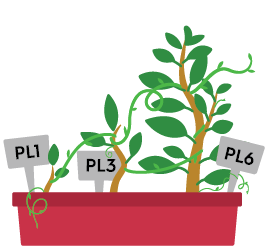This Snapshot will give K-12 educators ideas on how to apply the Proficiency Level Descriptors as they consider scaffolding practices that support multilingual students in meeting grade level content learning goals.
 Educators can create multimodal supports more intentionally for multilingual learners at all stages of English language development by identifying what their students can do and building on their linguistic assets.
Educators can create multimodal supports more intentionally for multilingual learners at all stages of English language development by identifying what their students can do and building on their linguistic assets.
To create these supports, educators can use the WIDA Proficiency Level Descriptors (PLDs), and the Language Expectations, both of which are provided in the WIDA English Language Development Standards Framework, 2020 Edition. PLDs and Language Expectations are described for students in grades K through 12.
What are Proficiency Level Descriptors?
PLDs are “a detailed articulation of multilingual learners" growth in interpretive and expressive language across levels of English language proficiency” (2020 Edition, p. 31). They are organized by the interpretive and expressive modes of communication and the three dimensions of language—discourse, sentence and word/phrase dimensions. Educators can use the PLDs to
- Examine Language Expectations across proficiency levels
- Inform differentiated scaffolding
Examine Language Expectations Across Proficiency Levels
Language Expectations are goals for content-driven language instruction that inform unit language goals. Language goals apply to all learners; however, the language students use as they reach those language goals will differ. The PLDs can guide educators to think more deeply about how, for example, a multilingual learner at the beginning stages of learning English might sound compared to a learner at the intermediate or advanced stages of English learning while working towards the same language and content learning goals.
Recommendations
- Choose one PLD criterion as a focus by looking at the language goal for the unit and identifying the proficiency level of the expected language use.
- Select one PLD criterion to identify how students’ language progress may look or sound across proficiency levels as they engage in the language goal.
Inform Differentiated Scaffolding
Although unit language and content learning goals are not differentiated, the scaffolding practices each student needs will differ as they engage in interpreting instructional materials and expressing understandings.
Anticipating opportunities for students to stretch their linguistic repertoire includes not only looking at WIDA assessment scores, but also at samples of writing and oral language production, portfolios, and other artifacts. This holistic approach will help to identify where a student might be along the PLD continuum in each criterion.
Recommendations
- Reflect on the students who are learning together and their language backgrounds to consider how their languages can be leveraged to build their English proficiency.
- Give opportunities for students to engage in content and language in multimodal ways, offering multiple pathways.
Scaffolding in Action
In a 5th grade English language arts class, all students are expected to engage in a poetry unit where they are interpreting and expressing figurative language such as metaphors, similes and idioms. The English language specialist is collaborating with the language arts teacher to plan ways to scaffold the language of poetry in the unit by looking at the WIDA PLDs.
Create precise meanings through everyday, cross-disciplinary, and technical language with…
- some frequently used words and phrases with some precision (social studies, government)
- a small repertoire of words and phrases with developing precision (branches of government, executive power)
- a growing repertoire of words and phrases with growing precision (the founders, “two if by land…”)
- an expanding repertoire of words and phrases, including idioms and collocations with expanding precision (the lights are on but nobody’s home…)
- a flexible repertoire of words and phrases, such as adverbials of time, manner, and place; verb types; and abstract nouns; with consistent precision (as a result of the war, forming a new nation)
- a variety of words and phrases, including evaluation, obligation, idioms, and collocations (necessary sacrifices, outdated law, fit for a king)
Expressive Proficiency Level Descriptors for grades 4-5 are on page 138 of the WIDA ELD Standards Framework.
Choose one PLD criterion as a focus and identify the proficiency level of the expected language use
- Since students are not required to create complete sentences for their poems, both teachers focus on the Grades 4-5 PLDs for the expressive communication mode, looking specifically at the word/phrase dimension. They notice figurative language is mentioned in proficiency level 4.
- an expanding repertoire of words and phrases, including idioms and collocations with expanding precision (the lights are on but nobody’s home…)
Reflect on the students who are learning together and their language backgrounds
- They identify 3-5 multilingual learners in each class at the beginning levels of English language development.
- Most of them speak Spanish and a few are Chinese speakers.
- They consider poems that have been translated into these languages.
- They can group students by language for multilingual discussions.
Identify how students may sound across proficiency levels
- Multilingual students at the advanced and intermediate levels of English proficiency are ready to use a variety of expanded metaphors using increasingly complex English grammatical structures.
- Students at the beginning levels of English proficiency can build on their frequently used words and phrases and simple sentences by adding “like” and “as” to expand them into metaphors.
- some frequently used words and phrases with some precision (social studies, government)
Give opportunities for students to engage in content and language in multimodal ways
- Students have the option to create a written poem with illustrations or a spoken poem with images in video form.
- They also have the option to create their poems in multiple languages.





